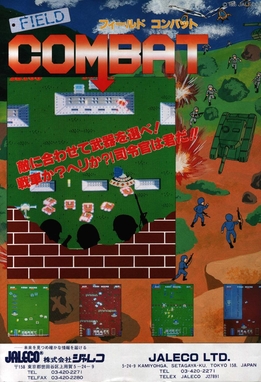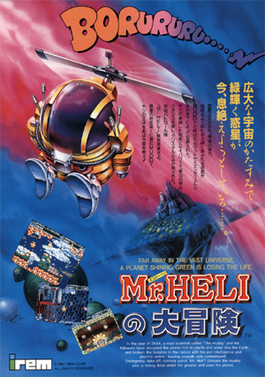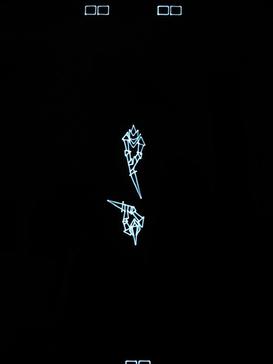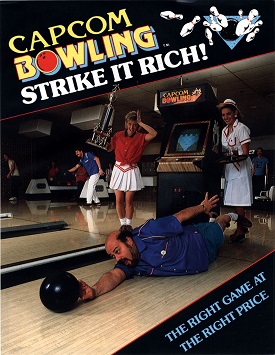| Bull Fight | |
|---|---|
 | |
| Developer(s) | Sega |
| Publisher(s) |
|
| Platform(s) | Arcade |
| Release | Arcade 1984 |
| Genre(s) | Isometric |
| Mode(s) | Up to 2 players, alternating turns |
Bull Fight is a coin-operated arcade game produced by Sega in 1984. [2] [3] [4] [5]
| Bull Fight | |
|---|---|
 | |
| Developer(s) | Sega |
| Publisher(s) |
|
| Platform(s) | Arcade |
| Release | Arcade 1984 |
| Genre(s) | Isometric |
| Mode(s) | Up to 2 players, alternating turns |
Bull Fight is a coin-operated arcade game produced by Sega in 1984. [2] [3] [4] [5]
The player assumes the role of a bullfighter attempting to defeat a bull. The bullfighter is controlled via a joystick and two buttons.
A sports video game is a video game that simulates the practice of sports. Most sports have been recreated with video games, including team sports, track and field, extreme sports, and combat sports. Some games emphasize playing the sport, whilst others emphasize strategy and sport management. Some, such as Need for Speed, Arch Rivals and Punch-Out!!, satirize the sport for comic effect. This genre has been popular throughout the history of video games and is competitive, just like real-world sports. A number of game series feature the names and characteristics of real teams and players, and are updated annually to reflect real-world changes. The sports genre is one of the oldest genres in gaming history.

Tomohiro Nishikado is a Japanese video game developer and engineer. He is the creator of the arcade shoot 'em up game Space Invaders, released to the public in 1978 by the Taito Corporation of Japan, often credited as the first shoot 'em up and for beginning the golden age of arcade video games. Prior to Space Invaders, he also designed other earlier Taito arcade games, including the shooting electro-mechanical games Sky Fighter (1971) and Sky Fighter II, the sports video game TV Basketball in 1974, the vertical scrolling racing video game Speed Race in 1974, the multi-directional shooter Western Gun in 1975, and the first-person combat flight simulator Interceptor (1975).

Gun Fight, known as Western Gun in Japan and Europe, is a 1975 multidirectional shooter arcade video game designed by Tomohiro Nishikado, and released by Taito in Japan and Europe and by Midway in North America. Based around two Old West cowboys armed with revolvers and squaring off in a duel, it was the first video game to depict human-to-human combat. The Midway version was also the first video game to use a microprocessor instead of TTL. The game's concept was adapted from Sega's 1969 arcade electro-mechanical game Gun Fight.

Captain America and the Avengers is a beat 'em up arcade game developed and released by Data East in 1991. It features the Avengers team of Marvel Comics characters in a side-scrolling brawling and shooting adventure to defeat the evil Red Skull. The game received ports for the Sega Genesis/Mega Drive, Super Nintendo Entertainment System, Game Boy and Game Gear. A different Data East game was released for the Nintendo Entertainment System.

Alpha Mission, known as ASO: Armored Scrum Object in Japan, is a vertically scrolling shooter developed by SNK and released as an arcade video game in 1985 by Namco in Japan and Tradewest in North America. It was later ported to the Famicom in 1986 and released for the Nintendo Entertainment System in 1987.

Field Combat is a 1985 shooter video game developed and published by Jaleco for arcades. In Field Combat, the player fights as a commanding officer in a futuristic battlefield. It was ported to the Famicom by Tose, which was later re-released for the Wii's Virtual Console in 2007. A sequel game, Field Combat DX, was released for Japanese mobile phones in 2004.

Super Xevious is a vertically scrolling shooter released as an arcade video game in Japan in 1984. It was developed and published by Namco as an updated version of Xevious (1982) created as a response to the overwhelming success of the original in Japan. It was sold as conversion kit for existing Xevious cabinets.

Boot Hill is a multidirectional shooter arcade video game released by Midway in 1977. It is a sequel to the 1975 video game Gun Fight, originally released by Taito as Western Gun in Japan. It was released under license from Taito, as Boot Hill is another version of Western Gun.

Avengers, sometimes known as Avenger and known in Japan as Hissatsu Buraiken, is a 1986 overhead-view vertical scrolling beat 'em up arcade game developed and published by Capcom. The game was directed by Takashi Nishiyama, who previously designed the side-scrolling beat 'em ups Kung-Fu Master (1984) and Trojan (1986), and later designed the original Street Fighter (1987) and several early SNK fighting games.

Batman is a horizontally scrolling beat 'em up arcade game released by Atari Games, Midway Games, Data East and Namco in 1990 in North America, and in 1991 in Japan and Europe.

Mr. Heli, fully titled in Japan as Mr. HELI no Daibōken is a multidirectional scrolling shooter developed and published in arcades in 1987 by Irem. It was released in North America as Battle Chopper.

Quartet (カルテット) is a run and gun video game released by Sega for arcades in 1986. Quartet allows one to four players to guide a set of characters through a base taken over by an army of robots. Players control either Joe (yellow), Mary (red), Lee (blue), or Edgar (green) across 32 side-scrolling levels. The object of the game is to advance through the level, fighting opponents that come out of portals in the walls, and eventually defeat a boss that carries the door key used to open the "exit door" for the level.

Warrior is a 1979 arcade fighting game. It is considered one of the first fighting games, excepting several boxing games such as Heavyweight Champ, released in 1976, and Atari's unreleased Boxer.

MagMax is an arcade video game which was developed by Nihon Bussan and released in 1985 under its brand Nichibutsu. A horizontal scrolling shooter, players control the title hover ship in an attempt to completely construct the ship into a giant robot and to destroy any enemies attempting to stop it.

Driver's Eyes is a 1991 3D driving simulation arcade game developed and published in Japan by Namco. The game has a pseudo-panoramic view using three CRT screens; the player would sit in a then-realistic Formula One car cockpit with LCD instruments. The game would start with the player selecting either "easy drive" or "technical drive". Once the selection was made the screen would show a 3D model of a Formula One car with a V8 engine being placed into the engine bay and then the body work gliding down. As that happened the camera view would change and reveal a sign saying "BRAKES ON". When the sign lifted the race would start.

Capcom Bowling is a top down bowling sports simulation game developed by Incredible Technologies and released by Capcom to arcades in 1988. Up to 4 four players could play a single game playing alternately. The controls feature a trackball which is used to control both direction and power, and two buttons which control left and right spin or hook. Comedic animations play for making certain shots.

Great Swordsman (グレートソードマン) is an arcade fighting game developed by Allumer and published by Taito in 1984. In 2005, it was later included in Taito Legends.
Shanghai Kid, sometimes titled The Shanghai Kid and known in Japan as Hokuha Syourin Hiryū no Ken, is a 1985 arcade fighting game developed by Nihon Game and published by Taiyo System. It is the first game in the Hiryū no Ken series by Culture Brain.

Treasure Island is a 1981 arcade video game from Data East. It was released for the DECO Cassette System as well as a standalone cabinet. Treasure Island is a vertically scrolling game with isometric graphics. The goal is to climb a sinking island while gathering treasure.